Sub-orbital spaceflight
| Part ofa serieson |
| Spaceflight |
|---|
 |
|
|
| Name | Year | Flights | Location |
|---|---|---|---|
| Mercury-Redstone 3 Mercury-Redstone 4 |
1961 | 2 | Cape Canaveral |
| X-15 Flight 90 X-15 Flight 91 |
1963 | 2 | Edwards AFB |
| Soyuz 18a | 1975 | 1 | Baikonur Cosmodrome |
| SpaceShipOne Flight 15P SpaceShipOne Flight 16P SpaceShipOne Flight 17P |
2004 | 3 | Mojave Air and Space Port |
| Blue Origin NS-16[1] Blue Origin NS-18 Blue Origin NS-19 |
2021 | 3 | Corn Ranch |
| Blue Origin NS-20 Blue Origin NS-21 |
2022 | 3 | |
| Blue Origin NS-25 | 2024 | 1 |
| Name | Year | Flights | Location |
|---|---|---|---|
| X-15 Flight 62 | 1962 | 1 | Edwards AFB |
| X-15 Flight 77 X-15 Flight 87 |
1963 | 2 | |
| X-15 Flight 138 X-15 Flight 143 X-15 Flight 150 X-15 Flight 153 |
1965 | 4 | |
| X-15 Flight 174 | 1966 | 1 | |
| X-15 Flight 190 X-15 Flight 191 |
1967 | 2 | |
| X-15 Flight 197 | 1968 | 1 | |
| Soyuz MS-10 | 2018 | 1 | Baikonur Cosmodrome |
| VSSUnityVP-03 | 2018 | 1 | Mojave Air and Space Port |
| VSSUnityVF-01 | 2019 | 1 | |
| VSSUnityUnity21 VSSUnityUnity22 |
2021 | 2 | Spaceport America |
| VSSUnityUnity25 Galactic 01 Galactic 02 Galactic 03 Galactic 04 Galactic 05 |
2023 | 6 | Spaceport America |
| Galactic 06 Galactic 07 |
2024 | 2 | Spaceport America |
Asub-orbital spaceflightis aspaceflightin which thespacecraftreachesouter space,but itstrajectoryintersects the surface of thegravitating bodyfrom which it was launched. Hence, it will not complete oneorbitalrevolution, will not become anartificial satellitenor will it reachescape velocity.
For example, the path of an object launched fromEarththat reaches theKármán line(about 83 km [52 mi] – 100 km [62 mi][2]abovesea level), and then falls back to Earth, is considered a sub-orbital spaceflight. Some sub-orbital flights have been undertaken to test spacecraft andlaunch vehicleslater intended fororbital spaceflight.Other vehicles are specifically designed only for sub-orbital flight; examples include crewed vehicles, such as theX-15andSpaceShipTwo,and uncrewed ones, such asICBMsandsounding rockets.
Flights which attain sufficient velocity to go intolow Earth orbit,and thende-orbitbefore completing their first full orbit, are not considered sub-orbital. Examples of this include flights of theFractional Orbital Bombardment System.
A flight that does not reach space is still sometimes called sub-orbital, but cannot officially be classified as a "sub-orbital spaceflight". Usually a rocket is used, but some experimental sub-orbital spaceflights have also been achieved via the use ofspace guns.[3]
Altitude requirement[edit]
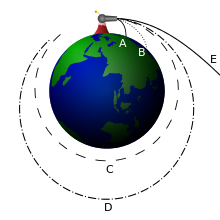
By definition, a sub-orbital spaceflight reaches analtitudehigher than 100 km (62 mi) abovesea level.This altitude, known as the Kármán line, was chosen by theFédération Aéronautique Internationalebecause it is roughly the point where a vehicle flying fast enough to support itself withaerodynamic liftfrom theEarth's atmospherewould be flying faster thanorbital speed.[4]The US military andNASAawardastronaut wingsto those flying above 50 mi (80 km),[5]although theU.S. State Departmentdoes not show a distinct boundary between atmospheric flight andspaceflight.[6]
Orbit[edit]
Duringfreefallthe trajectory is part of anelliptic orbitas given by theorbit equation.Theperigeedistance is less than theradius of the EarthRincluding atmosphere, hence theellipseintersects the Earth, and hence the spacecraft will fail to complete an orbit. The major axis is vertical, thesemi-major axisais more thanR/2. Thespecific orbital energyis given by:
whereis thestandard gravitational parameter.
Almost alwaysa<R,corresponding to a lowerthan the minimum for a full orbit, which is
Thus the net extra specific energy needed compared to just raising the spacecraft into space is between 0 and.
Speed, range, and altitude[edit]
To minimize the requireddelta-v(anastrodynamicalmeasure which strongly determines the requiredfuel), the high-altitude part of the flight is made with therocketsoff (this is technically called free-fall even for the upward part of the trajectory). (Compare withOberth effect.) The maximumspeedin a flight is attained at the lowest altitude of this free-fall trajectory, both at the start and at the end of it.[citation needed]
If one's goal is simply to "reach space", for example in competing for theAnsari X Prize,horizontal motion is not needed. In this case the lowest required delta-v, to reach 100 km altitude, is about 1.4km/s.Moving slower, with less free-fall, would require more delta-v.[citation needed]
Compare this with orbital spaceflights: a low Earth orbit (LEO), with an altitude of about 300 km, needs a speed around 7.7 km/s, requiring a delta-v of about 9.2 km/s. (If there were no atmospheric drag the theoretical minimum delta-v would be 8.1 km/s to put a craft into a 300-kilometer high orbit starting from a stationary point like the South Pole. The theoretical minimum can be up to 0.46 km/s less if launching eastward from near the equator.)[citation needed]
For sub-orbital spaceflights covering a horizontal distance the maximum speed and required delta-v are in between those of a vertical flight and a LEO. The maximum speed at the lower ends of the trajectory are now composed of a horizontal and a vertical component. The higher the horizontaldistancecovered, the greater the horizontal speed will be. (The vertical velocity will increase with distance for short distances but will decrease with distance at longer distances.) For theV-2 rocket,just reaching space but with a range of about 330 km, the maximum speed was 1.6 km/s.Scaled Composites SpaceShipTwowhich is under development will have a similar free-fall orbit but the announced maximum speed is 1.1 km/s (perhaps because of engine shut-off at a higher altitude).[citation needed][needs update]
For larger ranges, due to the elliptic orbit the maximum altitude can be much more than for a LEO. On a 10,000-kilometer intercontinental flight, such as that of an intercontinental ballistic missile or possible futurecommercial spaceflight,the maximum speed is about 7 km/s, and the maximum altitude may be more than 1300 km. Anyspaceflightthat returns to the surface, including sub-orbital ones, will undergoatmospheric reentry.The speed at the start of the reentry is basically the maximum speed of the flight. Theaerodynamic heatingcaused will vary accordingly: it is much less for a flight with a maximum speed of only 1 km/s than for one with a maximum speed of 7 or 8 km/s.[citation needed]
The minimum delta-v and the corresponding maximum altitude for a given range can be calculated,d,assuming a spherical Earth of circumference40000kmand neglecting the Earth's rotation and atmosphere. Let θ be half the angle that the projectile is to go around the Earth, so in degrees it is 45°×d/10000km.The minimum-delta-v trajectory corresponds to an ellipse with one focus at the centre of the Earth and the other at the point halfway between the launch point and the destination point (somewhere inside the Earth). (This is the orbit that minimizes the semi-major axis, which is equal to the sum of the distances from a point on the orbit to the two foci. Minimizing the semi-major axis minimizes thespecific orbital energyand thus the delta-v, which is the speed of launch.) Geometrical arguments lead then to the following (withRbeing the radius of the Earth, about 6370 km):
The altitude of apogee is maximized (at about 1320 km) for a trajectory going one quarter of the way around the Earth (10000km). Longer ranges will have lower apogees in the minimal-delta-v solution.
(wheregis the acceleration of gravity at the Earth's surface). The Δvincreases with range, leveling off at 7.9 km/s as the range approaches20000km(halfway around the world). The minimum-delta-v trajectory for going halfway around the world corresponds to a circular orbit just above the surface (of course in reality it would have to be above the atmosphere). See lower for the time of flight.
Anintercontinental ballistic missileis defined as a missile that can hit a target at least 5500 km away, and according to the above formula this requires an initial speed of 6.1 km/s. Increasing the speed to 7.9 km/s to attain any point on Earth requires a considerably larger missile because the amount of fuel needed goes up exponentially with delta-v (seeRocket equation).
The initial direction of a minimum-delta-v trajectory points halfway between straight up and straight toward the destination point (which is below the horizon). Again, this is the case if the Earth's rotation is ignored. It is not exactly true for a rotating planet unless the launch takes place at a pole.[7]
Flight duration[edit]
In a vertical flight of not too high altitudes, the time of the free-fall is both for the upward and for the downward part the maximum speed divided by theacceleration of gravity,so with a maximum speed of 1 km/s together 3 minutes and 20 seconds. The duration of theflightphases before and after the free-fall can vary.[citation needed]
For an intercontinental flight theboost phasetakes 3 to 5 minutes, the free-fall (midcourse phase) about 25 minutes. For an ICBM the atmospheric reentry phase takes about 2 minutes; this will be longer for any soft landing, such as for a possible future commercial flight.[citation needed]Test flight 4 of the SpaceX 'Starship'performed such a flight with a lift off from Texas and a simulated soft touchdown in the Indian Ocean 66 minutes after liftoff.
Sub-orbital flights can last from just seconds to days.Pioneer 1wasNASA's firstspace probe,intended to reach theMoon.A partial failure caused it to instead follow a sub-orbital trajectory, reentering the Earth's atmosphere 43 hours after launch.[8]
To calculate the time of flight for a minimum-delta-v trajectory, according toKepler's third law,the period for the entire orbit (if it did not go through the Earth) would be:
UsingKepler's second law,we multiply this by the portion of the area of the ellipse swept by the line from the centre of the Earth to the projectile:
This gives about 32 minutes for going a quarter of the way around the Earth, and 42 minutes for going halfway around. For short distances, this expression isasymptoticto.
From the form involving arccosine, the derivative of the time of flight with respect tod(or θ) goes to zero asdapproaches20000km(halfway around the world). The derivative of Δvalso goes to zero here. So ifd=19000km,the length of the minimum-delta-v trajectory will be about19500km,but it will take only a few seconds less time than the trajectory ford=20000km(for which the trajectory is20000kmlong).
Flight profiles[edit]
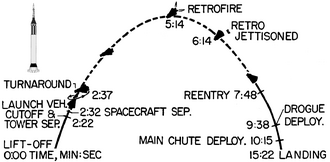
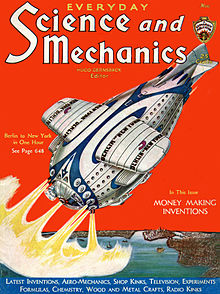
While there are a great many possible sub-orbital flight profiles, it is expected that some will be more common than others.
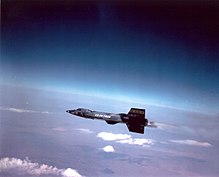
Ballistic missiles[edit]
The first sub-orbital vehicles which reached space wereballistic missiles.The first ballistic missile to reach space was the GermanV-2,the work of the scientists atPeenemünde,on October 3, 1942, which reached an altitude of 53 miles (85 km).[9]Then in the late 1940s the US andUSSRconcurrently developed missiles all of which were based on the V-2 Rocket, and then much longer range Intercontinental Ballistic Missiles (ICBMs). There are now many countries who possess ICBMs and even more with shorter rangeIntermediate Range Ballistic Missiles(IRBMs).[citation needed]
Tourist flights[edit]
Sub-orbital tourist flightswill initially focus on attaining the altitude required to qualify as reaching space. The flight path will be either vertical or very steep, with the spacecraft landing back at its take-off site.
The spacecraft will shut off itsengineswell before reaching maximum altitude, and then coast up to its highest point. During a few minutes, from the point when the engines are shut off to the point where the atmosphere begins to slow down the downward acceleration, the passengers will experienceweightlessness.
Megarochad been planned for sub-orbital spaceflight by theBritish Interplanetary Societyin the 1940s.[10][11]
In the autumn of 1945, the group M. Tikhonravov K. and N. G. Chernysheva at NII-4 rocket artillery Academy of Sciences technology on its own initiative the first stratospheric rocket project was developed byVR-190for vertical flight two pilots to an altitude of 200 km based on captured German ballistic rocketV-2.[12]
In 2004, a number of companies worked on vehicles in this class as entrants to the Ansari X Prize competition. TheScaled Composites SpaceShipOnewas officially declared byRick Searfossto have won the competition on October 4, 2004, after completing two flights within a two-week period.
In 2005,Sir Richard Bransonof theVirgin Groupannounced the creation ofVirgin Galacticand his plans for a 9-seat capacity SpaceShipTwo namedVSSEnterprise.It has since been completed with eight seats (one pilot, one co-pilot and six passengers) and has taken part in captive-carry tests and with the first mother-shipWhiteKnightTwo,orVMSEve.It has also completed solitary glides, with the movable tail sections in both fixed and "feathered" configurations. Thehybrid rocketmotor has been fired multiple times in ground-based test stands, and was fired in a powered flight for the second time on 5 September 2013.[13]Four additional SpaceShipTwos have been ordered and will operate from the newSpaceport America.Commercial flights carrying passengers were expected in 2014, but became cancelled due to thedisaster during SS2 PF04 flight.Branson stated, "[w]e are going to learn from what went wrong, discover how we can improve safety and performance and then move forwards together."[14]
Scientific experiments[edit]
A major use of sub-orbital vehicles today is asscientificsounding rockets.Scientific sub-orbital flights began in the 1920s whenRobert H. Goddardlaunched the firstliquid fueledrockets, however they did not reachspacealtitude. In the late 1940s, captured GermanV-2 ballistic missileswere converted intoV-2 sounding rocketswhich helped lay the foundation for modern sounding rockets.[15]Today there are dozens of different sounding rockets on the market, from a variety of suppliers in various countries. Typically, researchers wish to conduct experiments inmicrogravityor above the atmosphere.
Sub-orbital transportation[edit]
Research, such as that done for theX-20 Dyna-Soarproject suggests that a semi-ballistic sub-orbital flight could travel from Europe to North America in less than an hour.
However, the size of rocket, relative to the payload, necessary to achieve this, is similar to an ICBM. ICBMs have delta-v's somewhat less than orbital; and therefore would be somewhat cheaper than the costs for reaching orbit, but the difference is not large.[16]
Due to the high cost of spaceflight, suborbital flights are likely to be initially limited to high value, very high urgency cargo deliveries such ascourierflights,militaryfast-response operations orspace tourism.[opinion]
TheSpaceLineris a hypersonicsuborbital spaceplaneconcept that could transport 50 passengers fromAustraliatoEuropein 90 minutes or 100 passengers from Europe toCaliforniain 60 minutes.[17]The main challenge lies in increasing the reliability of the different components, particularly the engines, in order to make their use for passenger transportation on a daily basis possible.
SpaceXis potentially considering using theirStarshipas a sub-orbital point-to-point transportation system.[18]
Notable uncrewed sub-orbital spaceflights[edit]
- The first sub-orbital space flight was on 20 June 1944, whenMW 18014, a V-2 test rocket,launched fromPeenemündein Germany and reached 176 kilometres altitude.[19]
- Bumper5, a two-stage rocket launched from theWhite Sands Proving Grounds.On 24 February 1949 the upper stage reached an altitude of 248 miles (399 km) and a speed of 7,553 feet per second (2,302 m/s; Mach 6.8).[20]
- Albert II,a malerhesus macaque,became the first mammal in space on 14 June 1949 in a sub-orbital flight fromHolloman Air Force Basein New Mexico to an altitude of 83 miles (134 km) aboard a U.S.V-2 sounding rocket.
- USSR –Energia,15 May 1987, aPolyuspayload which failed to reach orbit
- SpaceXIFT-3,14 March 2024, first successfulStarshipflight test,most massive object launched into a sub-orbital trajectory to date.
Crewed sub-orbital spaceflights[edit]
Above 100 km (62.14 mi) in altitude.
| Date (GMT) | Mission | Crew | Country | Remarks | |
|---|---|---|---|---|---|
| 1 | 1961-05-05 | Mercury-Redstone 3 | Alan Shepard | First crewed sub-orbital spaceflight, first American in space | |
| 2 | 1961-07-21 | Mercury-Redstone 4 | Virgil Grissom | Second crewed sub-orbital spaceflight, second American in space | |
| 3 | 1963-07-19 | X-15 Flight 90 | Joseph A. Walker | First winged craft in space | |
| 4 | 1963-08-22 | X-15 Flight 91 | Joseph A. Walker | First person and spacecraft to make two flights into space | |
| 5 | 1975-04-05 | Soyuz 18a | Vasili Lazarev Oleg Makarov |
Failed orbital launch. Aborted after malfunction during stage separation | |
| 6 | 2004-06-21 | SpaceShipOne flight 15P | Mike Melvill | First commercial spaceflight | |
| 7 | 2004-09-29 | SpaceShipOne flight 16P | Mike Melvill | First of two flights to winAnsari X-Prize | |
| 8 | 2004-10-04 | SpaceShipOne flight 17P | Brian Binnie | Second X-Prize flight, clinching award | |
| 9 | 2021-07-20 | Blue Origin NS-16 | Jeff Bezos Mark Bezos Wally Funk Oliver Daemen |
First crewed Blue Origin flight | |
| 10 | 2021-10-13 | Blue Origin NS-18 | Audrey Powers Chris Boshuizen Glen de Vries William Shatner |
Second crewed Blue Origin flight | |
| 11 | 2021-12-11 | Blue Origin NS-19 | Laura Shepard Churchley Michael Strahan Dylan Taylor Evan Dick Lane Bess Cameron Bess |
Third crewed Blue Origin flight | |
| 12 | 2022-03-31 | Blue Origin NS-20 | Marty Allen Sharon Hagle Marc Hagle Jim Kitchen George Nield Gary Lai |
Fourth crewed Blue Origin flight | |
| 13 | 2022-06-04 | Blue Origin NS-21 | Evan Dick Katya Echazarreta Hamish Harding Victor Correa Hespanha Jaison Robinson Victor Vescovo |
Fifth crewed Blue Origin flight | |
| 14 | 2022-08-04 | Blue Origin NS-22 | Coby Cotton Mário Ferreira Vanessa O'Brien Clint Kelly III Sara Sabry Steve Young |
Sixth crewed Blue Origin flight | |
| 15 | 2024-05-19 | Blue Origin NS-25 | Mason Angel Sylvain Chiron Ed Dwight Kenneth Hess Carol Schaller Gopichand Thotakura |
Seventh crewed Blue Origin flight |
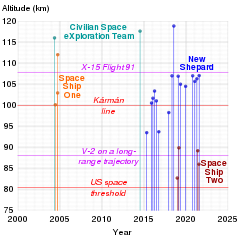
Future of crewed sub-orbital spaceflight[edit]
Private companiessuch asVirgin Galactic,Armadillo Aerospace(reinvented as Exos Aerospace),Airbus,[21]Blue OriginandMasten Space Systemsare taking an interest in sub-orbital spaceflight, due in part to ventures like the Ansari X Prize.NASAand others are experimenting withscramjet-basedhypersonicaircraft which may well be used with flight profiles that qualify as sub-orbital spaceflight.Non-profitentities likeARCASPACEandCopenhagen Suborbitalsalso attemptrocket-based launches.
See also[edit]
- Canadian Arrow
- CORONA
- DH-1 (rocket)
- Interorbital Systems
- Land of the Giants
- List of rocket launch sites
- Lunar Lander Challenge
- McDonnell Douglas DC-X
- Office of Commercial Space Transportation
- Project MorpheusNASA program to continue developing ALHAT and Q landers
- Quad (rocket)
- Reusable Vehicle Testingprogram byJAXA
- Rocketplane XP
- Spaceport
- SpaceX reusable launch system development program
- Supersonic transport
- XCOR Lynx
References[edit]
- ^Foust, Jeff (20 July 2021)."Blue Origin launches Bezos on first crewed New Shepard flight".SpaceNews.Retrieved20 Jul2021.
- ^https://scholar.smu.edu/cgi/viewcontent.cgi?article=1126&context=jalc
- ^"Martlet".Archived fromthe originalon 2010-09-26.
- ^"100 km Altitude Boundary for Astronautics".Fédération Aéronautique Internationale.Archived fromthe originalon 2011-08-09.Retrieved2017-09-14.
- ^Whelan, Mary (5 June 2013)."X-15 Space Pioneers Now Honored as Astronauts".nasa.gov.Archivedfrom the original on 11 June 2017.Retrieved4 May2018.
- ^"85. U.S. Statement, Definition and Delimitation of Outer Space And The Character And Utilization Of The Geostationary Orbit, Legal Subcommittee of the United Nations Committee on the Peaceful Uses of Outer Space at its 40th Session in Vienna from April".state.gov.Retrieved4 May2018.
- ^Blanco, Philip (September 2020). "Modeling ICBM Trajectories Around a Rotating Globe with Systems Tool Kit".The Physics Teacher.58(7): 494–496.Bibcode:2020PhTea..58..494B.doi:10.1119/10.0002070.S2CID225017449.
- ^"Pioneer 1 - NSSDC ID: 1958-007A".NASA NSSDC.
- ^Germany's V-2 Rocket, Kennedy, Gregory P.
- ^Hollingham, Richard."How a Nazi rocket could have put a Briton in space".bbc.Archivedfrom the original on 14 November 2016.Retrieved4 May2018.
- ^"Megaroc".bis-space.Archivedfrom the original on 30 October 2016.Retrieved4 May2018.
- ^Anatoli I. Kiselev; Alexander A. Medvedev; Valery A. Menshikov (December 2012).Astronautics: Summary and Prospects.Translated by V. Sherbakov; N. Novichkov; A. Nechaev. Springer Science & Business Media. pp. 1–2.ISBN9783709106488.
- ^"Scaled Composites: Projects - Test Logs for SpaceShipTwo".Archivedfrom the original on 2013-08-16.Retrieved2013-08-14.
- ^"Branson on Virgin Galactic crash: 'Space is hard – but worth it'". CNET. Retrieved August 1, 2015.
- ^"ch2".history.nasa.gov.Archivedfrom the original on 2015-11-29.Retrieved2015-11-28.
- ^"The Space Review: Point-to-point suborbital transportation: sounds good on paper, but..."thespacereview.Archivedfrom the original on 1 August 2017.Retrieved4 May2018.
- ^Sippel, M. (2010)."Promising roadmap alternatives for the SpaceLiner"(PDF).Acta Astronautica.66(11–12): 1652–1658.Bibcode:2010AcAau..66.1652S.doi:10.1016/j.actaastro.2010.01.020.
- ^Ralph, Eric (30 May 2019)."SpaceX CEO Elon Musk wants to use Starships as Earth-to-Earth transports".Teslarati.Retrieved31 May2019.
- ^Walter Dornberger, Moewig, Berlin 1984.ISBN3-8118-4341-9.
- ^ "Bumper Project".White Sands Missile Range. Archived fromthe originalon 2008-01-10.
- ^Amos, Jonathan (3 June 2014)."Airbus drops model 'space jet'".BBC News.Archivedfrom the original on 4 May 2018.Retrieved4 May2018.















